INFINITI G-CONVERTIBLE 2012 Owners Manual
Manufacturer: INFINITI, Model Year: 2012, Model line: G-CONVERTIBLE, Model: INFINITI G-CONVERTIBLE 2012Pages: 474, PDF Size: 3.63 MB
Page 421 of 474
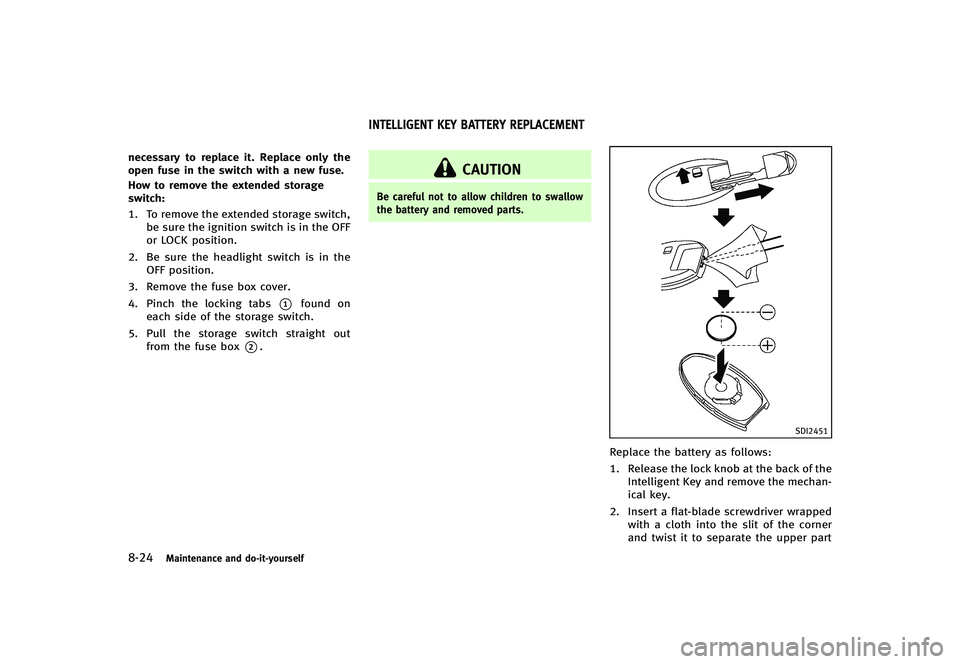
8-24Maintenance and do-it-yourself
necessary to replace it. Replace only the
open fuse in the switch with a new fuse.
How to remove the extended storage
switch:
GUID-D73A39BF-43C8-459F-9C24-47B7F579C4071. To remove the extended storage switch,be sure the ignition switch is in the OFF
or LOCK position.
2. Be sure the headlight switch is in the OFF position.
3. Remove the fuse box cover.
4. Pinch the locking tabs
*1found on
each side of the storage switch.
5. Pull the storage switch straight out from the fuse box
*2.
GUID-1F9B8636-7E6E-45E3-956E-110F7CC84D80
CAUTION
Be careful not to allow children to swallow
the battery and removed parts.
SDI2451
Replace the battery as follows:
1. Release the lock knob at the back of theIntelligent Key and remove the mechan-
ical key.
2. Insert a flat-blade screwdriver wrapped with a cloth into the slit of the corner
and twist it to separate the upper part
INTELLIGENT KEY BATTERY REPLACEMENT
Page 422 of 474

from the lower part.
3. Replace the battery with a new one.
Recommended battery: CR2032 or
equivalent.
.Do not touch the internal circuit andelectric terminals as it could cause a
malfunction.
.Hold the battery by the edges.
Holding the battery across the con-
tact points will seriously deplete the
storage capacity.
.Make sure that the + side faces thebottom of the case.SDI2452
4. Align the tips of the upper and lower
parts
*1, and then push them together
until it is securely closed
*2.
5. Push the buttons two or three times to check its operation.
See an INFINITI retailer if you need any
assistance for replacement.
FCC Notice:
For USA:
This device complies with Part 15 of the
FCC Rules. Operation is subject to the
following two conditions: (1) This device
may not cause harmful interference, and
(2) this device must accept any interfer- ence received, including interference that
may cause undesired operation.
NOTE:
Changes or modifications not expressly
approved by the party responsible for
compliance could void the user’s authority
to operate the equipment.
For Canada:
This device complies with RSS-210 of
Industry Canada. Operation is subject to
the following two conditions: (1) this
device may not cause interference, and
(2) this device must accept any interfer-
ence, including interference that may
cause undesired operation of the device.
Maintenance and do-it-yourself8-25
Page 423 of 474
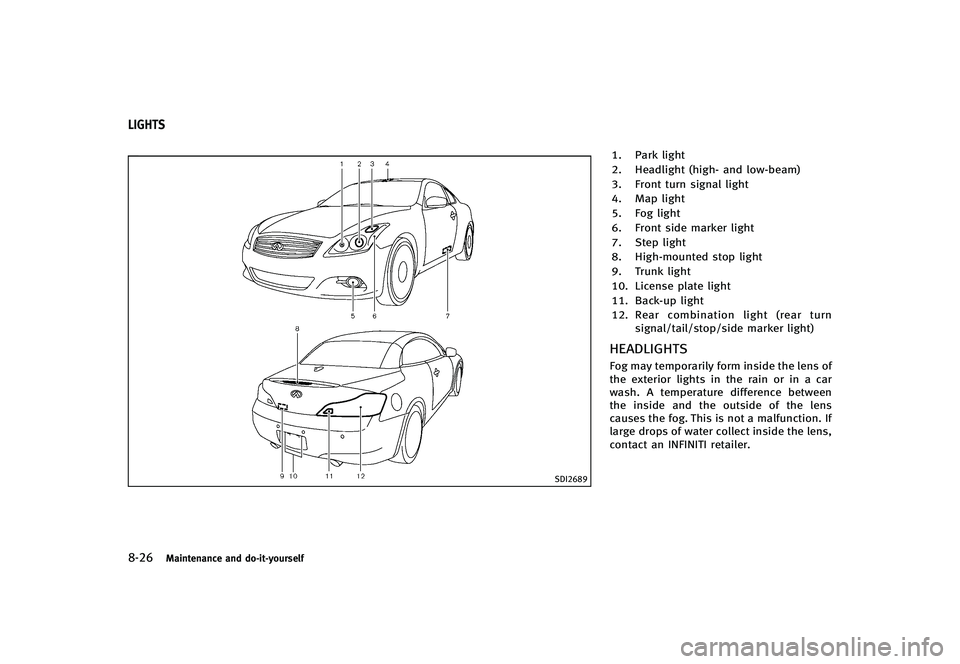
8-26Maintenance and do-it-yourself
GUID-665EF07E-CA6A-4029-AF72-186775404E12
SDI2689
1. Park light
2. Headlight (high- and low-beam)
3. Front turn signal light
4. Map light
5. Fog light
6. Front side marker light
7. Step light
8. High-mounted stop light
9. Trunk light
10. License plate light
11. Back-up light
12.Rear combination light (rear turn
signal/tail/stop/side marker light)
HEADLIGHTSGUID-C87085ED-F66B-42A0-99E1-D2BD088C4FE1Fog may temporarily form inside the lens of
the exterior lights in the rain or in a car
wash. A temperature difference between
the inside and the outside of the lens
causes the fog. This is not a malfunction. If
large drops of water collect inside the lens,
contact an INFINITI retailer.
LIGHTS
Page 424 of 474

ReplacingGUID-88120AB8-4362-425B-AA97-7EAEBE6D932D
WARNING
HIGH VOLTAGE
When xenon headlights are on, they pro-
duce a high voltage. To prevent an electric
shock, never attempt to modify or disas-
semble. Always have your xenon headlights
replaced at an INFINITI retailer. For addi-
tional information, see “Headlight and turn
signal switch” (P.2-33).
Use the same number and wattage shown
in the following chart as originally in-
stalled.
If replacement is required, see an INFINITI
retailer.
EXTERIOR AND INTERIOR LIGHTSGUID-393F947F-6862-41D4-907E-84C0FFD9CE45Item Wattage (W)Bulb No.
Headlight*
High/Low beams (Xenon) 35D2S
Front turn signal light* 21WY21W
Front fog light* 55H11
Park light* 5W5W
Front side marker light* 5W5W
Rear combination light*
back-up 16W16W
turn signal 21W21W
stop/tail/side marker LED—
License plate light* 5W5W
Puddle light* LED—
Map light 8—
Vanity mirror light 2—
Step light* 8—
Trunk light* 5—
High-mounted stop light* LED—
*: See an INFINITI retailer for replacement.
NOTE: Always check with the Parts Depart-
ment at an INFINITI retailer for the latest
information about parts.
Maintenance and do-it-yourself8-27
Page 425 of 474
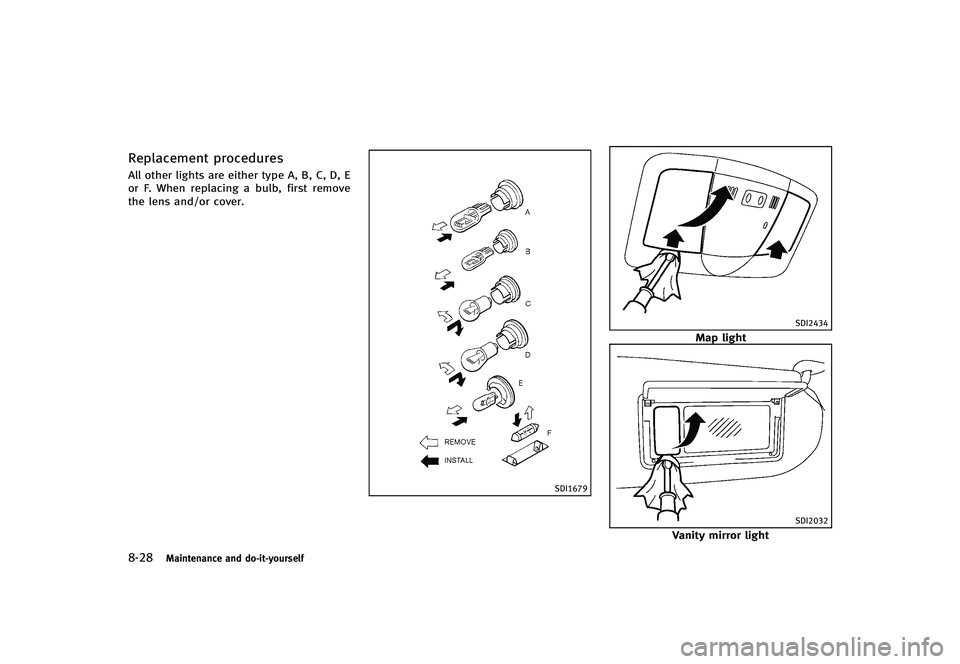
8-28Maintenance and do-it-yourself
Replacement proceduresGUID-5BB9E577-90D9-4F0B-BE3B-7C6419FCEB27All other lights are either type A, B, C, D, E
or F. When replacing a bulb, first remove
the lens and/or cover.
SDI1679
SDI2434
Map light
SDI2032
Vanity mirror light
Page 426 of 474
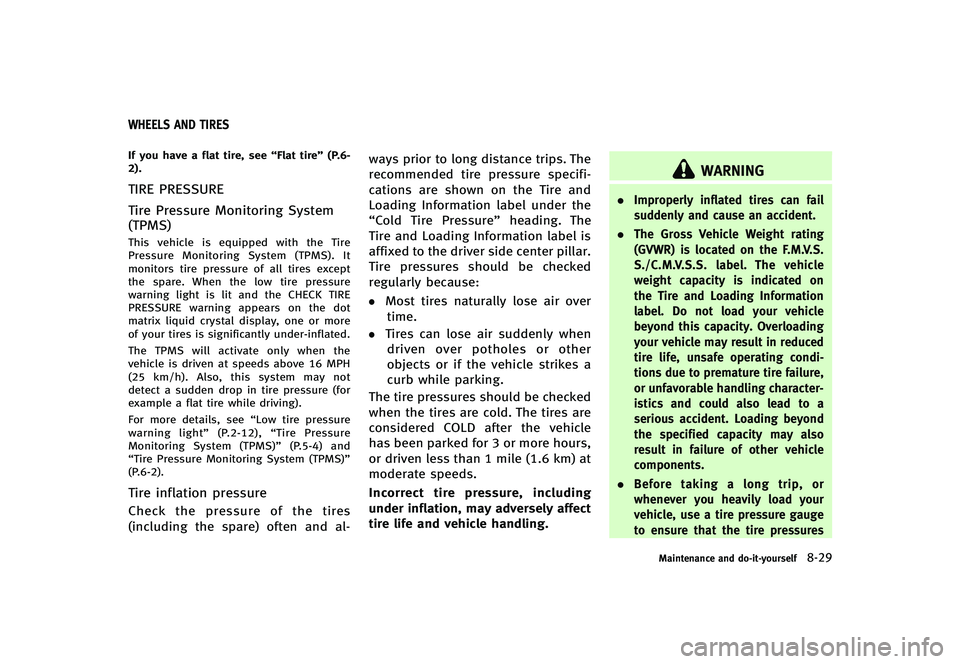
GUID-1FF8645E-BD26-49E1-8ACE-3D93C44CADF6If you have a flat tire, see“Flat tire”(P.6-
2).
TIRE PRESSUREGUID-BDD15B46-98E3-4A60-8D4D-2328B8986E37
Tire Pressure Monitoring System
(TPMS)
GUID-92F1DBE9-C4EF-4679-8E12-AEDD5231258DThis vehicle is equipped with the Tire
Pressure Monitoring System (TPMS). It
monitors tire pressure of all tires except
the spare. When the low tire pressure
warning light is lit and the CHECK TIRE
PRESSURE warning appears on the dot
matrix liquid crystal display, one or more
of your tires is significantly under-inflated.
The TPMS will activate only when the
vehicle is driven at speeds above 16 MPH
(25 km/h). Also, this system may not
detect a sudden drop in tire pressure (for
example a flat tire while driving).
For more details, see “Low tire pressure
warning light” (P.2-12),“Tire Pressure
Monitoring System (TPMS)” (P.5-4) and
“Tire Pressure Monitoring System (TPMS)”
(P.6-2).
Tire inflation pressureGUID-1E5BCB99-CF5B-436E-822C-36E9EA89ED84Check the pressure of the tires
(including the spare) often and al- ways prior to long distance trips. The
recommended tire pressure specifi-
cations are shown on the Tire and
Loading Information label under the
“Cold Tire Pressure”
heading. The
Tire and Loading Information label is
affixed to the driver side center pillar.
Tire pressures should be checked
regularly because:
.Most tires naturally lose air over time.
.Tires can lose air suddenly whendriven over potholes or other
objects or if the vehicle strikes a
curb while parking.
The tire pressures should be checked
when the tires are cold. The tires are
considered COLD after the vehicle
has been parked for 3 or more hours,
or driven less than 1 mile (1.6 km) at
moderate speeds.
Incorrect tire pressure, including
under inflation, may adversely affect
tire life and vehicle handling.
WARNING
. Improperly inflated tires can fail
suddenly and cause an accident.
. The Gross Vehicle Weight rating
(GVWR) is located on the F.M.V.S.
S./C.M.V.S.S. label. The vehicle
weight capacity is indicated on
the Tire and Loading Information
label. Do not load your vehicle
beyond this capacity. Overloading
your vehicle may result in reduced
tire life, unsafe operating condi-
tions due to premature tire failure,
or unfavorable handling character-
istics and could also lead to a
serious accident. Loading beyond
the specified capacity may also
result in failure of other vehicle
components.
. Before taking a long trip, or
whenever you heavily load your
vehicle, use a tire pressure gauge
to ensure that the tire pressures
Maintenance and do-it-yourself8-29
WHEELS AND TIRES
Page 427 of 474
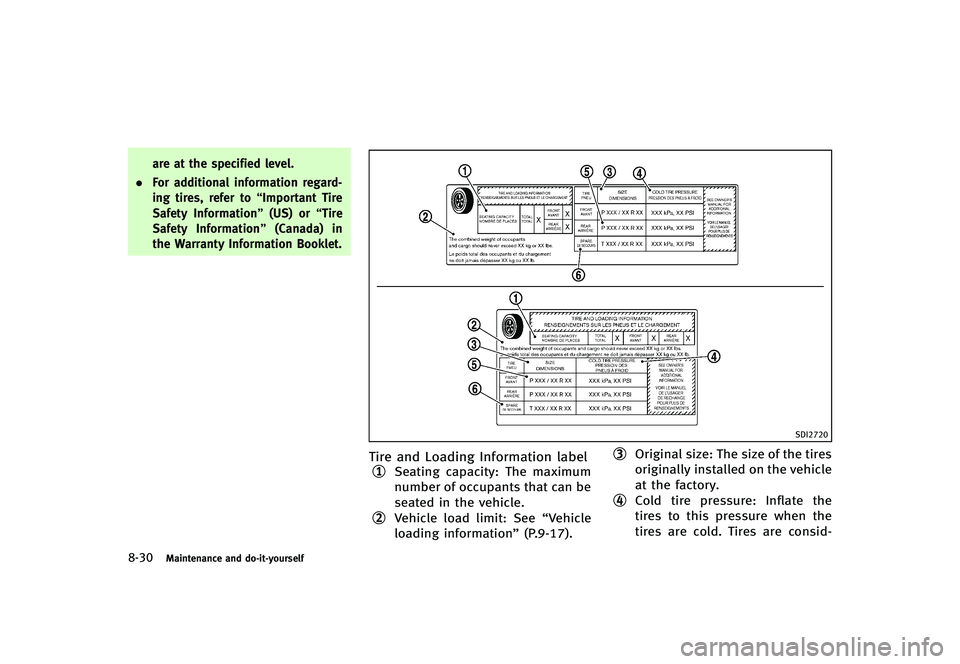
8-30Maintenance and do-it-yourself
are at the specified level.
. For additional information regard-
ing tires, refer to “Important Tire
Safety Information ”(US) or “Tire
Safety Information ”(Canada) in
the Warranty Information Booklet.
SDI2720
Tire and Loading Information labelGUID-0CCE6085-7E8E-4C48-ABCC-DBD2555096F8*1Seating capacity: The maximum
number of occupants that can be
seated in the vehicle.
*2Vehicle load limit: See “Vehicle
loading information” (P.9-17).
*3Original size: The size of the tires
originally installed on the vehicle
at the factory.
*4Cold tire pressure: Inflate the
tires to this pressure when the
tires are cold. Tires are consid-
Page 428 of 474

ered COLD after the vehicle has
been parked for 3 or more hours,
or driven less than 1 mile (1.6
km) at moderate speeds. The
recommended cold tire inflation
is set by the manufacturer to
provide the best balance of tire
wear, vehicle handling, driveabil-
ity, tire noise, etc., up to the
vehicle’s GVWR.
*5Tire size—see “Tire labeling”
(P.8-32).
*6Spare tire size or compact spare
tire size (if so equipped)
SDI1949
Checking the tire pressureGUID-6180484A-6593-4643-801D-6889016CD8CA1.Remove the valve stem cap from
the tire.
2.Press the pressure gauge
squarely onto the valve stem. Do
not press too hard or force the
valve stem sideways, or air will
escape. If the hissing sound of air
escaping from the tire is heard
while checking the pressure, re-
position the gauge to eliminate
this leakage.
3.Remove the gauge.
4.Read the tire pressure on the
gauge stem and compare it to
the specification shown on the
Tire and Loading Information la-
bel.
5.Add air to the tire as needed. If
too much air is added, press the
core of the valve stem briefly with
the tip of the gauge stem to
release pressure. Recheck the
pressure and add or release air
as needed.
6.Install the valve stem cap.
7.Check the pressure of all other
tires, including the spare.
Maintenance and do-it-yourself8-31
Page 429 of 474

8-32Maintenance and do-it-yourself
SIZECOLD TIRE
INFLATION
PRESSURE
FRONT
ORIGINAL TIRE 225/45R19 96W
XL
270 kPa,
39 PSI
P225/50R18 94V 260 kPa,
38 PSI
REAR ORI-
GINAL TIRE 245/40R19 98W
XL
270 kPa,
39 PSI
P245/45R18 96V 260 kPa,
38 PSI
SPARE TIRE T145/70D18
107M 420 kPa,
60PSI
SDI1575
Example
TIRE LABELINGGUID-C591E2BD-CAF2-47B8-A4FE-A6CF0FC5130AFederal law requires tire manufac-
turers to place standardized informa-
tion on the sidewall of all tires. This
information identifies and describes
the fundamental characteristics of
the tire and also provides the tire
identification number (TIN) for safety
standard certification. The TIN can be
used to identify the tire in case of a
recall.
SDI1606
Example*1Tire size (example: P215/60R16
94H)
1.P: The
“P”indicates the tire is
designed for passenger vehicles.
(Not all tires have this informa-
tion.)
2.Three-digit number (215): This
number gives the width in milli-
meters of the tire from sidewall
edge to sidewall edge.
3.Two-digit number (60): This num-
ber, known as the aspect ratio,
Page 430 of 474

gives the tire’s ratio of height to
width.
4.R: The“R”stands for radial.
5.Two-digit number (16): This num-
ber is the wheel or rim diameter in
inches.
6.Two- or three-digit number (94):
This number is the tire’s load
index. It is a measurement of
how much weight each tire can
support. You may not find this
information on all tires because it
is not required by law.
7.H: Tire speed rating. You should
not drive the vehicle faster than
the tire speed rating.
SDI1607
Example*2TIN (Tire Identification Number)
for a new tire (example: DOT XX XX
XXX XXXX)
1.DOT: Abbreviation for the “Depart-
ment of Transportation”. The sym-
bol can be placed above, below or
to the left or right of the Tire
Identification Number.
2.Two-digit code: Manufacturer’s
identification mark
3.Two-digit code: Tire size
4.Three-digit code: Tire type code
(Optional)
5.Three-digit code: Date of Manu-
facture
6.Four numbers represent the week
and year the tire was built. For
example, the numbers 3103
means the 31st week of 2003. If
these numbers are missing, then
look on the other sidewall of the
tire.
*3Tire ply composition and materi-
al
The number of layers or plies of
rubber-coated fabric in the tire.
Tire manufacturers also must
indicate the materials in the tire,
which include steel, nylon,
polyester, and others.
*4Maximum permissible inflation
pressure
This number is the greatest
amount of air pressure that
should be put in the tire. Do
not exceed the maximum per-
Maintenance and do-it-yourself8-33